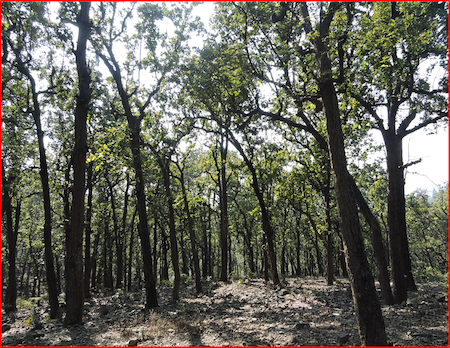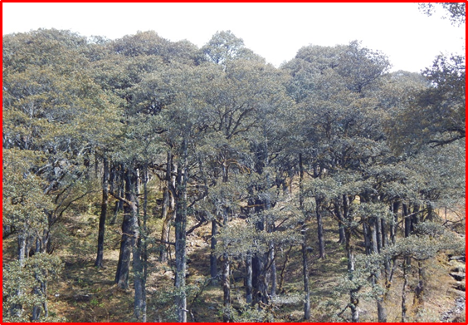We recently celebrated the International day of Forests all across the world to show our reverence towards forests and realise their role in our life. Appreciating the vast importance of forests for mankind and to generate mass awareness about the of significant role of forests in our life, the UN General Assembly declared 21st March to be celebrated as International Day of Forests worldwide and every year the day is celebrated with great fervour and festivity at regional, national and global levels by the way of various activities related to trees and forests.
Every year a separate theme is suggested for this day. The theme for International Day of Forests 2023 is ‘forests and health. Forests are the greatest gifts of nature to humanity. Franklin Delano Roosevelt, the renowned statesman and 32nd president of United States of America characterized Forests as the lungs of our land, which purify the air and give us strength. Similarly Buddhist Sutra describes forests as entities of infinite kindness and benevolence that serves all living beings without any demand.
This is absolutely true that our existence on this earth depends on forests. Apart from the aesthetic beauty, these natural ecosystems provide us myriad goods and services, which can be categorised under provisioning, regulating, cultural and supporting framework. Forests give us food, fodder, timber, non-timber forests products (NTFP)s, fruits, they purify air, checks soil erosion, regulates hydrological regimes, sequester carbon, supports bio-diversity etc., We are living in Himachal Himalayas and this mountains state is well known for its green grandeur.

Nature has bestowed numerous things to us. Glacier fed perennial rivers, hill streams, enchanting valleys, snow-covered towering peaks, beautiful lakes and lush-green meadows are the precious ornaments of this small hilly state. In addition to this, the mosaic of different forest-types spread across the various climatic zones of the state constitute an invaluable treasure trove. Albeit, Himachal Pradesh barely constitutes less than 2% area of the total geographical expanse of India. Nevertheless, about 27.73% area is covered under forests. There exist wide altitudinal variations, diverse climatic conditions, varied topography and physical setting across different biogeographic zones of the state and interplay of these multiple factors attributed to different types of forests.
According to the technical classification, eight main forest types and 37 forest sub-types are found in Himachal Pradesh. On the basis of the structural composition/vegetation, these gorgeous forests are named as Himalayan moist temperate forests, Himalayan dry temperate forests, tropical dry deciduous forests, sub-tropical, and alpine forests, etc. Distributed across the varied altitudinal zonation of the state, Himachal Forests epitomise a magical attraction and also holds immense significance. That’s why these marvellous natural entities are named as lustring GREEN PEARLS.
Almost, at every twist and turn, the panoramic view of forested valleys spread far and wide silently explains the nature’s marvel. Nothing looks more beautiful than the landscapes adorned with variety of vegetation. The sight of hill slopes covered with beautiful catchment forests provide a soothing touch to the eyes of beholder and the beauty of these woods cannot be confined in words. In fact, these wooded landscapes create a complex and characteristic ecosystem in which wide range of plants and animal’s species co-exist in perfect equilibrium. Certainly, trees are the principal structural components or building blocks of woods and numerous tree species are found in the different forest types of Himachal Pradesh.

These include the evergreen conifers represented by deodars, chirpine, blue-pine, silver fir, spruce, yews and broad leafed trees like variegated oaks, red and pink rhododendron, maples, boxwood, dogwood, alders, axlewood, ash tree, hazelnuts, horse chestnuts, birch, etc. Conifer tree species either exist as pure strands or mixed with oaks and maples, etc. Some species like chilgoza-pine (Pinus gerardiana) are found only in specific regions of the state. In Himachal Pradesh, pure Chilgoza pine forests are found in Pavari, Baspa, Karchchum, Akpa area of district Kinnaur and the species has also been recorded in Pangi and Bharmour parts of Chamba district. The cones of this high altitude conifer species yield very nutritious edible nuts. These are called as Chilgoza or Neoza. Due to the restricted distribution in limited areas such species are called as endemic species.
Famous Canadian writer Charles de Lint stated that “All forests have their own personality.” Likewise, every type of forests within the state holds its own charisma and beauty. Simply, a little glimpse of this kaleidoscopic natural wealth of the state is just awesome.




Hill Forests are also rich repository of biodiversity and act as excellent habitat for the plentiful animals, reptiles, pheasants, etc. The important wild-life of the state is represented by leopard black bear, barking deer, Porcupine, Goral, and colourful pheasants like Western Tragopan, Monal A plethora of important medicinal plants atish (Aconitum heterophyllum), hathpanja (Dactylorhiza hatagirea), ban-kakri (Podophyllum hexandrum), Angelica (Angelica glauca), Karru (Picrorhiza kurroa), Spikenard (Nardostachys grandiflora) is also found in these forests. In hill the life is comparatively tough and people living in forest fringe villages are profoundly dependent on forests.




Unfortunately, forests are under severe pressure all over the globe due to number of reasons. Mountain forests are no exception and facing many threats like illicit felling, damage due to anthropogenic activities like road construction/expansion, forest fires, and invasive species. It is heartening that latest Indian state of Forest Report (ISFR, 2021), showed an increase in the forest area Himachal Pradesh, but the reports states that area under Moderately Dense Forests (MDF) and Open Forests in the state has decreased.
In hilly areas, the life of the people living in fringe villages is profoundly dependent on the forests and, human settlements are found in the vicinity of moderately dense forests. Even in the urban and sub- urban areas the members of the civil society consider forests as garbage bins and throw all kinds rubbish inside the woods. The heaps of the plastic bottles, wrappers, rags in the forest areas look unpleasant, chokes water channels and pollutes the soils. All these are major serious cause of concern. As our existence dependents on forests so we need to protect this precious wealth for our own sake.

With over 15 years of experience in Forest Ecology, Soil Analysis, and Herbarium methods, Dushyant Kumar, from Himalayan Forest Research Institute (HFRI), Shimla, has published research and technical papers related to Plant diversity, Forest Soil Properties and Medicinal plants.
Preferring to stay close to nature life cycles, he is a staunch supporter of sustainable management of nature’s resources of forests, land and rivers.




Very informative article….. great job……..